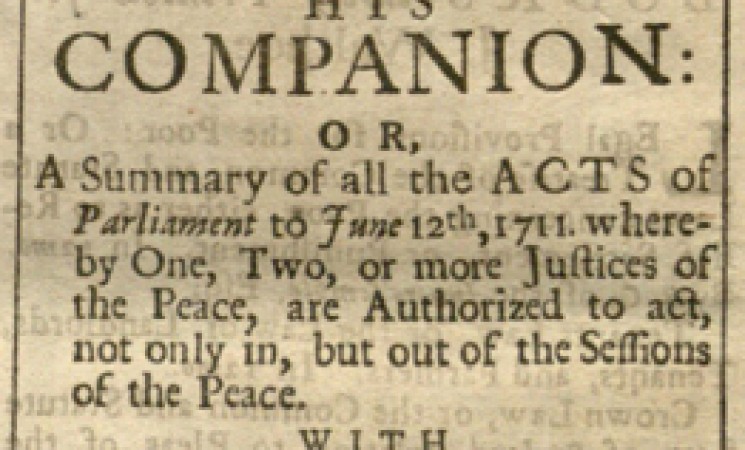The Taussig Collection: Justice of the peace manuals

Among the 363 English law titles the Lillian Goldman Law Library acquired from Anthony Taussig, by far the largest group is justice of the peace (JP) manuals. Taussig wrote to me that “I have pursued justice of the peace manuals because from a very early date they provide interesting overviews, constantly revised, of the areas of law of contemporary importance.”
In the preface to his Office and authority of a justice of peace (London, 1704), William Nelson gives a colorful synopsis of the office’s roots in the Middle Ages: “The Office of a Justice of Peace did at first consist chiefly in suppression of Riots and unlawful Assemblies, it being usual in former times for men of Estates to give Liveries every Year to rude and disorderly people who were not their Menial Servants, and this was to engage them in all their Quarrels for that Year…”
From the JP’s origins in criminal law, the office grew to become the most important in local government, with extensive judicial and administrative powers. Although Justices of the peace were drawn from the local elite, few them had legal training. Thus the need for guidance, met by the JP manual. As Parliament frequently changed the duties of JPs, new JP manuals and form books were published with the updated information. JP manuals became consistent best sellers for their publishers.
We have covered some of the authors of JP manuals in previous posts on the Taussig Collection: William Lambarde, whose Eirenarcha Is considered the best JP manual of the 16th century; William Sheppard; and Giles Jacob.
The highlight of the Taussig JP manuals is the very first printed JP manual:

The boke of iustyces of peas (London: Wynkyn de Worde, 1506). This anonymous work went through over thirty editions in the 16th century, under various titles. It was never adequately updated and soon became obsolete.
Other JP manuals from the Taussig Collection include…

Anthony Fitzherbert (1470-1538), Loffice et auctoryte des justyces de peas (London, 1538). This is the first edition of Fitzherbert’s popular JP manual, but the only edition in Law French. There were ten editions of English translation, three of which we acquired from Taussig to join the two we already had. The Taussig acquisition also included four of the six expanded editions of Fitzherbert’s JP manual prepared by Richard Crompton.

Michael Dalton, The countrey iustice: containing the practise of the iustices of the peace out of their sessions (London, 1619). Dalton’s Country Justice went through 20 editions, the last in 1746, and was often plagiarized for other JP manuals. This second edition is one of five we acquired from Taussig.

Forms for proceedings on such seizures, as by the late act for preventing frauds, &c. in the publick revenues, are to be heard and determined by justices of the peace (London, 1720). This form book for JPs is one of the rarest items in the Taussig Collection; the only other known copies are at the British Library and the National Library of Scotland.
To learn more about the history of justice of the peace manuals, see:
- Larry M. Boyer, “The Justice of the Peace in England and America from 1506 to 1776: A Bibliographic History,” The Quarterly Journal of the Library of Congress 34:4 (Oct. 1977), 315-326.
- W. S. Holdsworth, Sources and literature of English law (Oxford: Clarendon Press, 1925), 126-130.
- B. H. Putnam, Early treatises on the practice of the justices of the peace in the fifteenth and sixteenth centuries (Oxford: Clarendon Press, 1924).
– MIKE WIDENER, Rare Book Librarian


